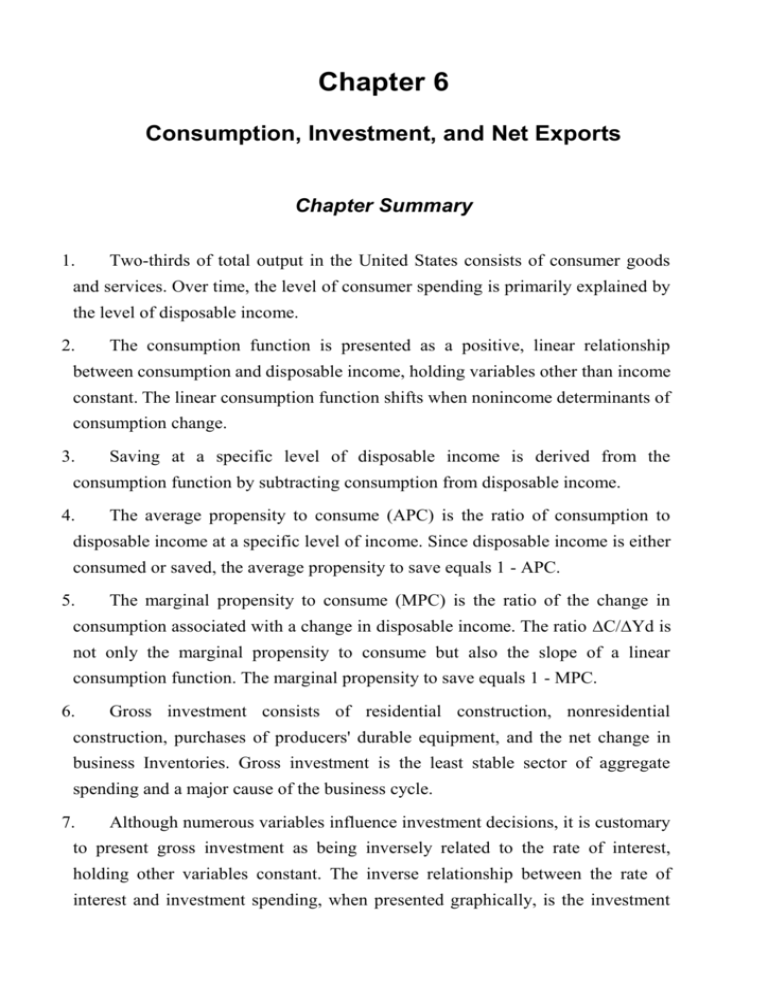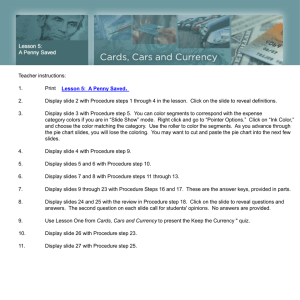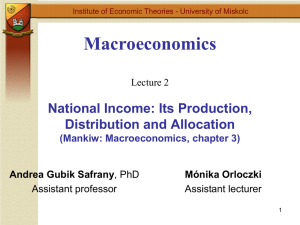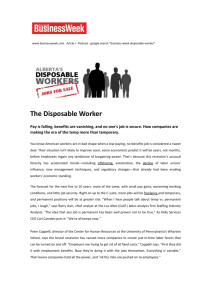Chapter 6
advertisement

Chapter 6 Consumption, Investment, and Net Exports Chapter Summary 1. Two-thirds of total output in the United States consists of consumer goods and services. Over time, the level of consumer spending is primarily explained by the level of disposable income. 2. The consumption function is presented as a positive, linear relationship between consumption and disposable income, holding variables other than income constant. The linear consumption function shifts when nonincome determinants of consumption change. 3. Saving at a specific level of disposable income is derived from the consumption function by subtracting consumption from disposable income. 4. The average propensity to consume (APC) is the ratio of consumption to disposable income at a specific level of income. Since disposable income is either consumed or saved, the average propensity to save equals 1 - APC. 5. The marginal propensity to consume (MPC) is the ratio of the change in consumption associated with a change in disposable income. The ratio ∆C/∆Yd is not only the marginal propensity to consume but also the slope of a linear consumption function. The marginal propensity to save equals 1 - MPC. 6. Gross investment consists of residential construction, nonresidential construction, purchases of producers' durable equipment, and the net change in business Inventories. Gross investment is the least stable sector of aggregate spending and a major cause of the business cycle. 7. Although numerous variables influence investment decisions, it is customary to present gross investment as being inversely related to the rate of interest, holding other variables constant. The inverse relationship between the rate of interest and investment spending, when presented graphically, is the investment demand curve. The investment demand curve shifts when noninterest variables that influence investment decisions change. 8. Net exports, which is the value of gross exports minus gross imports, represents the net addition of exports and imports to spending on domestic output. When there is a positive net export balance (gross exports exceed gross imports), there is a net addition to spending on domestic output. Net exports for the United States have been negative in recent years; international trade has had a negative effect on spending for U.S.-produced goods and services. 9. The exchange rate between the U.S. dollar and the currencies of foreign countries affects U.S. exports and U.S. imports. An appreciation of the U.S. dollar has a negative effect on net U.S. exports since a stronger dollar discourages U.S. exports and encourages U.S. residents to import more foreign-made goods. Important Terms Appreciation of the U.S. dollar. An increase in the value of the dollar relative to the unit currency of another nation; one U.S. dollar then buys more units of a foreign currency. Autonomous consumption. Consumer spending which is unrelated to the receipt of income. Average propensity to consume (APC). The ratio of consumption to disposable income at a given level of income. (APC=C/Yd) Average propensity to save (APS). The ratio of saving to disposable income at a given level of income (APS = S/Yd) Consumption function. The relationship between consumption and disposable income. Gross exports. The value of domestic production that is sold to other countries. Gross imports. The value of foreign production that is purchased by the domestic economy. Gross Investment. The sum of residential construction, nonresidential construction, the purchase of producers' durable equipment by businesses, and the net change in business inventories Induced consumption. An increase in consumer spending that results from an increase in income, Investment demand curve. A curve that shows the relationship between gross investment and the rate of interest, holding constant other variables that affect investment spending Marginal propensity to consume (MPC). The ratio of the change in consumption to the change in disposable income. (MPC = ∆C/∆Yd) Marginal propensity to save (MPS). The ratio of the change in saving to the change in disposable income. (MPS =∆S/∆Yd) Net exports. Gross exports minus gross imports. Saving function. The relationship between saving and disposable income. Outline of Chapter 6: Consumption, Investments, and Net Exports 6.1 Consumption 6.2 The Consumption function 6.3 The Average and Marginal Propensity to Consume and Save 6.4 Investment 6.5 The Investment Demand Curve 6.6 Gross Exports and Gross Imports 6.1 CONSUMPTION Because consumption represents two-thirds of total aggregate spending in the United States, understanding the determinants of consumer spending is central to any analysis of the U.S. economy's level of output. Consumer spending is largely determined by personal income, income taxes, consumer expectations, consumer indebtedness, wealth, and the price level. Since consumption is impossible for most individuals without income earned from employment or through transfers from business or government, personal income is by far the most important of these variables. Personal income taxes are also central in that one's ability to spend depends not upon the income received but on the income available for spending. Figure 6-1 plays the dependency of consumer spending upon disposable income. Consumption, however, does not have a perfect linear relationship to disposable income in Fig. 6-1, indicating that other variables influence decision to consume. Although less important, consumer confidence, consumer indebtedness, wealth, and the price level also affect consumer spending in the short run. EXAMPLE 6.1. Annual levels of consumption and disposable income for the United States are plotted in Fig. 6-1 1975 through 1993. A line fitted to the data shows the dependency of consumption on disposable income. Note that consumption is sometimes above the regression line (1976, 1977, 1987, 1988, 1989) and other times below (1980, 198l, 1982, 1984, 1985, 1986, 1992). Consumption is likely to move above the regression line when the economy is expanding rapidly and consumer optimism results in consumers spending a larger than normal percent of their disposable income Consumption usually falls below the regression line when the economy is in a recession as output is considerably below full employment. As economic activity peaks, consumer indebtedness is usually high, consumers become less confident, and individuals tend to be less willing and/or able to continue spending as large a percent of their disposable income. 6.2 THE CONSUMPTION FUNCTION A consumption function is the relationship of consumption to disposable income, holding nonincome determinants of consumption constant. Table 6-1 presents a consumption function for a hypothetical economy. The data from Table 6-1 are plotted in Fig. 6-2 and the consumption function is labeled C'. A change in a nonincome determinant of consumption alters the relationship of consumption to disposable income. Such changes are depicted graphically by upward or downward shifts of the consumption function. Shifts of the consumption function affect the level of consumption and saving. Should consumers expect an increase in the price level, they are likely to spend more in the current period before prices rise. An upward shift of consumption function C' to C" results in more consumption and less saving at each income level. Table 6-1 (in Billions of Dollars) Disposable Income (Yd) 500 550 600 650 700 750 800 Consumption (c) 500 540 580 620 660 700 740 Saving (S =Yd- C) 0 10 20 30 40 50 60 EXAMPLE 6.2. The consumption function for a hypothetical economy is presented in schedule form in Table 6-1 and graphically in Fig. 6-2. From columns 1 and 2 of Table 6-1 we find that consumers spend their entire disposable income when Y d is $500 billion and spend less than their disposable income at income levels greater than $500 billion. Since disposable income is either consumed or saved, consumer saving (column 3) is found by deducting consumption from disposable income. Consumption and disposable income from Table 6-1 are plotted in Fig. 6-2, and the resulting is labeled C'. (The 45º line in Fig 6-2 is equidistant mm both the consumption and disposable income axes. As drawn, C = Y d at each point on this 45º line.) For linear consumption function C’, there is only one level of disposable me at which consumer spending equals disposable income, and that is the point of intersection of the consumption and the 45º line. Since the consumption line is below the 45º line at disposable income levels above $500 billion, it follows that consumers are not consuming their entire income and therefore are saving. Thus, consumer saving is the distance between the consumption line and the 45º line at each level of disposable income. EXAMPLE 6.3. Suppose consumers become more optimistic and are more willing to spend their disposable income. Such a trend would shift consumption function C' in Fig. 6-2 upward to C". We now find that at disposable income $500 billion, consumption exceeds disposable income, i.e., consumers are dissaving. (Consumers can dissave-consume more than their disposable incomes- by borrowing or by spending accumulated savings.) Consumption now equals disposable income when Yd is $600 billion; for consumption function C" there is less saving at each level of disposable income than there is for consumption function C'. 6.3. THE AVERAGE AND MARGINAL PROPENSITY TO CONSUME AND SAVE The relationship between consumption and disposable income can be presented by several ratios. The average propensity to consume is the ratio of consumption to disposable income at a specific level of income (APC = C/Yd) while the average propensity to save is the ratio of saving to disposable income (APS=S/Y d). Obviously, at each income level, APC + APS equals 1. For the consumption function in Table 6-2, the APC is 1 and the APS is 0 when disposable income is $500 billion, indicating that consumers are spending 100% of their disposable income. At disposable income levels greater than $500 on, the APC is less than 1; consumers are now saving and the APS is greater than 0. The marginal propensity to consume is the ratio of the change in consumption relative to the change in disposable income between two levels of disposable income (MPC= ∆C/∆Yd), while the marginal propensity to save is the ratio of the change in saving relative to the change in disposable income (MPS = ∆S/∆Yd). From Table 6-2,consumption increases from $500 billion to $540 billion when disposable income increases from $500 billion to $550 billion; the MPC is therefore 0.80 since ∆C of $40 divided by ∆Yd of $50 equals 0.80. For the linear consumption function C’ in Fig. 6-2, the marginal propensity to consume is 0.80 for each change in disposable income. The MPC is constant for a linear consumption function since the MPC (∆C/∆Yd) is the consumption function's slope, and all straight lines have a constant slope. EXAMPLE 6.4. The APC and MPC for the data from Table 6-1 are presented in Table 6-2. Note that the APC falls from 1.0 to 0.92 as disposable income increases from $500 billion to $800 billion. Since the APS is 1- APC, the APS increases from 0 to 0.08. Consumers are not saving at disposable income level $500 billion, but they save 8% of their income level when Yd is $800 billion. The MPC is constant at 0.80, that is, 80% of each increase in disposable income is consumed. The MPS is 0.20 since MPS is 1- MPC. Table 6-2 APC (C'/Yd) 500/500=1.0 540/550=0.98 580/600=0.97 620/650=0.95 660/700=0.94 700/750=0.93 740/800=0.92 APS 0 0.02 0.03 0.05 0.06 0.07 0.08 Yd 500 550 600 650 700 750 800 C 500 540 580 620 660 700 740 MPC (∆C/∆Yd) 40/50=0.80 40/50=0.80 40/50=0.80 40/50=0.80 40/50=0.80 40/50=0.80 40/50=0.80 6.4 INVESTMENT Gross investment is the least stable component of aggregate spending and a principal cause of the business cycle (see Example 6.5). In the national income accounts, investment consists of residential construction (single-family and multifamily units); nonresidential construction (offices, hotels, and other commercial real estate); producers' durable equipment (equipment purchases by businesses); and changes in business inventories. Numerous variables affect these categories of gross investment. (See Example 6.6.) While the rate of interest is one of many variables that influence investment decisions, it is customary to present investment demand as a negative function of the rate of interest, holding constant the other variables which influence the decision to invest. EXAMPLE 6.5. Figure 6-3 presents the annual percentage change in real GDP, real gross investment, and the peaks and troughs in economic activity in the United States between 1970 and 1993. Both real GDP and real investment display a cyclical movement, rising after a business cycle trough and falling after a business cycle peak. Investment pending, however, displays larger and more dramatic changes. It is because of this that investment is considered the principal cause of economic fluctuations. Monetary policy seeks to dampen economic fluctuations by moderating the growth of investment spending during an economic expansion and slowing the decline in investment spending during a recession. EXAMPLE 6.6. While it is customary to link investment to the rate of interest, there are numerous noninterest variables, which influence the decision to invest. Residential construction depends upon the willingness and ability of individuals to purchase housing units. This demand is influenced by (1) demographics (the size of the house-buying population); (2) the indebtedness of potential house-buying individuals; (3) the wealth of such individuals (and therefore their ability to come up with the down payment); (4) their current and expected income level; (5) consumer confidence and willingness to incur new debt; (6) the ability of potential home buyers to obtain a loan from a financial institution; (7) the cost of housing units; and (8) the mortgage rate of interest which determines the monthly cost of carrying a mortgage. Nonresidential construction is dependent upon the willingness and ability of business units to buy commercial property. Their demand depends upon (1) the rate of interest, (2) the vacancy rate of existing units, (3) the needs of business units for additional commercial space, and (4) the ability of business units to meet increased rental costs which are directly linked to their current and expected costs and sales. Orders for producers' durable equipment are linked to (1) borrowing costs, since many of these large-ticketed items must be financed, (2) the utilization of existing productive capacity, (3) the availability of advanced, more efficient technology, (4) current and expected sales, and (5) existing and future competition. Changes in business inventories are linked to the rate of interest because there is an interest cost associated with carrying larger inventories. Inventory levels are also linked to current and expected sales, current and expected inventory prices, and certainty of inventory deliveries. 6.5 THE INVESTMENT DEMAND CURVE An investment demand curve shows the relationship between gross investment and the rate of interest, holding constant other variables that affect investment spending. In Fig. 6-4, investment spending is inversely related to the rate of interest, i.e., a lower rate of interest is associated with a higher level of investment, while a higher rate of interest is associated with a lower level of investment. This relationship is reasonable for the categories of investment enumerated in Section 6.4. Holding other variables constant, we would expect that at a lower rate of interest (1) more households are financially able and willing to carry a mortgage, and a greater number of housing units will be demanded; (2) businesses are more willing and able to purchase durable equipment and to carry larger inventories; and (3) real estate developers find that there are a larger number of purchasers for newly constructed commercial real estate. EXAMPLE 6.7. Figure 6-4 presents investment demand line I' for a hypothetical economy where the level of investment is $75 billion when the rate of interest is 8% and $85 billion when the rate of interest is 6%, holding constant other variables that influence investment spending. Should more households become more willing to purchase residential units at each rate of interest, more businesses elect to expand plant capacity at each rate of interest, and more business units demand nonresidential units, investment line I' would shift outward to I". Investment spending for investment demand line I" would now be $80 billion at an 8% rate of interest and $90 billion at a 6% rate of interest. 6.6 GROSS EXPORTS AND GROSS IMPORTS Gross exports are the value of goods and services produced in a home country (e.g., the United States) and sold abroad; i.e., gross exports are the value of foreign spending on U.S.-produced goods and services. Gross imports are the value of U.S. purchases of goods and services produced in other countries. When commodities are imported, some of the consumption and gross investment spending discussed earlier is for foreign-produced rather than U.S.-produced goods. Imports thereby lower aggregate spending on domestically produced goods. Net exports are the value of gross exports less gross imports, i.e., the net addition to domestic aggregate spending that results from importing and exporting goods and services. Net exports are positive when the home country exports more than it imports, and negative when the home country imports more than it exports. Figure 6-5 presents U.S. gross exports, gross imports, and net exports in 1987 dollars from 1975 through 1993. Note the substantial growth of gross exports and gross imports in the 1980s. Also note that the United States had a negative net export balance in 14 of these 19 years-aggregate spending on U.S.-produced goods and services was lower in 14 of these 19 years because of a negative net export balance. Numerous variables affect a country's imports and exports. A country's imports are related to its level f income, foreign exchange rate, domestic prices relative to prices in foreign countries, import tariffs, and restrictions on imported goods. Exports are influenced by the same variables, except that the income levels of foreign countries rather than that of the home country affect the amount exported. Because these variables change with time, it is reasonable to expect a country's net export balance to change over time. EXAMPLE 6.8. The gross exports of a home country (e.g., the United States) increase when (1) economic activity in a foreign country increases and more goods are purchased from U.S. producers; (2) the U.S. dollar depreciates (the international value of the U.S. dollar falls) and foreigners buy more U.S.-produced commodities because they have come relatively less expensive; (3) prices in a foreign country rise but are unchanged in the United States, making U.S.-produced goods relatively less expensive than those produced in the foreign country; (4) a foreign country lowers tariff on goods imported from the United States; and (5) a foreign country no longer prohibits the importation of certain goods produced in the United States. U.S. (home country) gross imports increase when (1) U.S. production levels rise, (2) the U.S. dollar appreciates in value; (3) the U.S. inflation rate exceeds that of foreign countries; and (4) United States lowers tariffs on imports. Solved Problems CONSUMPTION 6.1. Data on consumption and real GDP for the United States are presented in Table 6-3. (a) Consumption is what percent of real GDP in 1970, 1975, 1980, 1985, and 1990? (b) What explanation might one offer for the relative importance of consumer spending in the United States? Table 6-3 Consumption, Personal Disposable Income, and GDP for the United States (Billions of 1987 Dollars) Consumption Durable goods Nondurable goods Services Personal disposable income Gross domestic product SOURCE: 1970 1813.5 183.7 717.2 912.5 2025.3 2873.9 1975 2097.5 226.8 767.1 1103.6 2355.4 3221.7 1980 2447.1 262.7 860.5 1323.9 2733.6 3776.3 1985 2865.8 370.1 958.7 1537.0 3162.1 4279.8 1990 3272.6 443.1 1060.7 1768.8 3524.5 4897.3 Economic Report of the President, 1994 (a) Consumer spending was 63% of real GDP in 1970 (C/GDP = $1813. 5/$2873.9 = 0.63 = 0.63%); it was 65% in 1975, 65% in 1980, 67% in 1985, and 67% in 1990. (6) Individuals own the factors of production in the United States. Thus, we would expect that individuals would use most of their income for the purchase of goods and services. All production does not flow to individuals since (1) various levels of government impose taxes to finance government expenditures, and (2) individuals save some of their current income, which is loaned to businesses to finance the purchase of durable equipment and commercial real estate. 6.2. (a) From the data in Table 6-3, calculate consumption as a percent of disposable income. (b) Is the relationship of consumption to disposable income stable? What does this suggest? (c) Table 6-3 also presents the major components of consumption. Calculate each of these components as a percent of disposable income. (d) Has the relative importance of each consumption component changed during the twenty-year period? (a) Consumption as a percent of disposable income appears in Table 6-4. (b) The relationship of consumption to disposable income is relatively stable for these selected years; this suggests that consumer spending is largely dependent upon the receipt of disposable income. (c) Durable goods, nondurable goods, and services as a percent of disposable income are presented in Table 6-4. (0) Nondurable goods expenditures are of decreasing relative importance, while expenditures on services have become the major component of consumer spending by 1990. Note the increasing relative importance of durable goods expenditures: while it is the least important component of consumer spending, its relative importance has increased between 1970 and 1990. Table 6-4 Relationship of Consumer Spending to Disposable Income Consumption/disposable income Durable goods/disposable income Nondurables/disposable income Services/disposable income 6.3. 1970 1975 1980 1985 89.5% 89.1% 89.5% 90.6% 9.1% 9.6% 9.6% 11.7% 35.4% 32.6% 31.5% 30.3% 45.1% 46.9% 48.4% 48.6% 1990 92.9% 12.6% 30.1% 50.2% In Figure 6-6, annual percentage changes in the three major components of consumption are plotted for the United States from 1975 through 1993. Which component has the most and the least cyclical behavior? Service expenditures are the least cyclical since they demonstrate the most stable year-to-year percentage change. Durable goods purchases are the least stable and therefore the most cyclical spending category. The behavior of durable goods purchases is not surprising since these are large-ticketed purchases which can usually be postponed during periods when consumers become pessimistic about the future. THE CONSUMPTION FUNCTION 6.4. Suppose a household has the consumption function C presented in Fig. 6-7. (a) Find consumption when disposable income is $12,000 and $14,000. (b) Find consumption when disposable income is $10,000. How can a household consume more than its disposable income? (c) What is true of every point on the 450 line? (a) When disposable income is $12,000, consumption is $12,000. When disposable income is $14,000, consumption is $13,000. (b) This household consumes $11,000 when its disposable income is $10,000. A household can consume more than its income (dissave) by drawing accumulated savings from earlier periods or by borrowing. (c) Any point on the 450 line is equidistant from the consumption and disposable income axes when the same scales of measurement are used on both axes. Thus, at point B in Fig. 6-7, C = Yd. 6.5. (a) What is the relationship between consumption, saving, and disposable income? (b) Using Fig. 6-7, find saving when disposable income is $10,000, $12,000, and $14,000, and (c) identify the dissaving and saving areas. (d) Use the information in Fig. 6-7 to present in Fig. 6-8 a saving function. Put saving on the vertical axis and disposable income on the horizontal axis. (a) Disposable income is either consumed or saved. Thus, Yd = C + S, or S = Yd – C, (b) Since S = Yd – C, saving is 0 when disposable income is $12,000, –$1000 when disposable income is $10,000, and +$1000 when disposable income is $14,000. The amount saved is the vertical distance between the consumption function and the 450 line at each level of disposable income. (c) The saving area is the vertical distance between the consumption line and the 450 line to the right of point B. The dissaving area is the vertical distance between the consumption line and the 450 line to the left of point B. (d) The saving levels found in part (b) are plotted in Fig. 6-8, and the resulting line, labeled S, is the saving function. 6.6. Suppose the economy's consumption function is specified by the equation C = $50 + 0.80 Yd . (a) Find consumption when disposable income (I'd) is $400, $500, and $600. (b) Plot this consumption equation C = $50 + 0.80Yd in Fig. 6-9 and label it C'. (c) Use the consumption function in Fig. 6-9 to find saving when disposable income is $400, $500, and $600. (a) Consumption for each level of disposable income is found by substituting the specified disposable income level into the consumption equation. Thus, for Yd = $400, C = $50 + 0.80($400); C = $50 + $320; C = $370. C is $450 when Yd is $500, and $530 when Yd is $600. (b) The linear consumption equation C = $50 + 0.80Yd is plotted and labeled C' in Fig. 6-9 for the consumption and disposable income levels found in part (a). (c) Saving is the difference between disposable income and consumption. Using the calculation from part (a), we find that saving is $30 when Yd is $400 (Yd – C = S; $400 -$370 = $30), $50 when Yd is $500, and $70 when Yd is $600. Saving in Fig. 6-9 is the difference between the consumption line and the 450 line at each level of disposable income. Thus, reading up from the $400 income level, we find that C is $370 for consumption function C'; the distance from consumption function C' to the 450 line at the $400 income level is $30-the amount of saving. 6.7. Autonomous consumption is the amount of consumption spending which is unrelated to income. Induced consumption is that consumption which is dependent upon the receipt of income. (a) What amount of consumption for consumption function C' in Fig. 6-9 is autonomous, and what amount is induced when disposable income is $400? $500? $600? (b) Find autonomous consumption and induced consumption from the consumption equation C $50 + 0.80Yd when Yd is $500. (a) Autonomous consumption is the amount consumed when disposable income is 0. In Fig. 6-9, autonomous consumption is $50, the amount consumed when the consumption line C' intersects the vertical axis and disposable income is 0. Since autonomous consumption is unrelated to income, autonomous consumption is $50 for all levels of income for consumption function C' in Fig. 6-9. induced consumption is the amount of consumption that depends upon the receipt of income. Consumption is $370 when disposable income is $400; since $50 is consumed regardless of the income level, $320 of the $370 level of consumption is induced by disposable income. Induced consumption is $400 when disposable income is $500, and $480 when disposable income is $600. (b) Autonomous consumption is $50, the constant of the consumption equation. Induced consumption is the amount of consumption attributable to disposable income. Thus, when disposable income is $500, 0.80 of Yd ($400) is induced consumption. 6.8. What should happen to consumption function C' in Fig. 6-9 when (a) consumers consider their job secure and therefore become more confident about the future level of disposable income? (b) credit card issuers implement tighter credit standards and consumers are less able to buy goods and services on credit? (c) consumers expect the price level to increase 10% by the end of the year? (a) Consumers become more willing to consume their current disposable income. Consumption function C' in Fig. 6-9 shifts upward, and consumption is greater for each level of disposable income. (b) Some consumers are no longer able to borrow to purchase goods and services in the current period. Consumption function C' in Fig. 6-9 shifts downward. Consumption is lower for each level of disposable income. (c) Consumers reschedule future purchases to the current period because of the expected rise in prices for goods and services. Consumption function C' in Fig. 6-9 shifts upward. Consumption is higher for each level of disposable income. THE AVERAGE AND MARGINAL PROPENSITY TO CONSUME AND SAVE 6.9. (a) Use the consumption function C' in Fig. 6-9 to find the average propensity to consume (APC) and the average propensity to save (APS) when the level of disposable income is $250, $300, and $400. (b) What does the marginal propensity to consume (MPC) measure? (c) From Fig. 6-9, find the MPC when income increases from $250 to $300 and from $300 to $400. (d) What is the relationship between the APC and the APS? The MFC and the MPS? (a) The APC = C/Yd and the APS = S/Yd . When disposable income is $250, consumption is $250; the APC equals $250/250 = 1 and the APS equals 0/$250 = 0. When disposable income is $300, consumption is $290; the APC = $290/$300 = 0.97 and the APS = 0.03. The APC = 0.925 when disposable income is $400 and consumption is $370; the APS = 0.075. (b) The marginal propensity to consume (MPC) is the ratio of the change in consumption to the change in disposable income, i.e., the fraction of each change in disposable income that is consumed. The MPC is the slope of a linear consumption function. (c) Consumption increases $40 (from $250 to $290) when disposable income increases $50 (from $250 to $300). Thus, the MPC is 0.80 (MPC = C/Yd; MPC = $40/$50 = 0.80). Consumption increases $80 (from $290 to $370) when disposable income increases $100 (from $300 to $400); the MPC is not unexpectedly 0.80 since the MPC is constant for a linear consumption function. (d) Since disposable income is either consumed or saved, the average propensity to consume plus the average propensity to save must equal 1 (i.e., APC + APS = C/Yd + S/Yd = 1). Similarly, MPC + MPS = 1. 6.10. Suppose an increase in household sector wealth shifts consumption function C' upward to C" in Fig. 6-9. (a) Find the APC at the $400 income level. What has happened to the average propensity to consume at the $400 income level as a result of this upward shift of the consumption function? (b) Find the MPC when income increases from $400 to $500. What happens to the MPC when there is a parallel shift of the consumption function? (a) The APC is 1.0 ($400/$400) at the $400 income level for consumption function C". The APC has increased from 0.925 at the $400 income level for consumption function C' to 1.0 for consumption function C". The upward shift of the consumption function has resulted in consumers spending a larger percent of their current income. (b) The MPC is 0.80. Parallel shifts of a consumption function do not change the marginal propensity to consume since the slope of the consumption line has not changed. 6.11. Suppose consumption is $9000 when disposable income is $10,000. (a) Find consumption when disposable income is $11,000 and $12,000 when the marginal propensity to consume is 0.60. (b) Find saving when disposable income is $10,000, $11,000, and $12,000. (c) Find the APC and the APS when disposable income is $10,000, $11,000, and $12,000. (d) What is the marginal propensity to save? (a) Since 0.60 of every change in income is consumed, consumption increases $600 for each $1000 increase in disposable income. Since consumption is $9000 when income is $10,000, consumption is $9600 when income is $11,000 and $10,200 when income is $12,000. (b) Saving is the difference between disposable income and consumption. Thus, saving is $1000 when income is $10,000, $1400 when income is $11,000, and $1800 when income is $12,000. (c) The APC is 0.90 when income is $10,000 (APC $9000/$l0,000 = 0.90), 0.87 when income is $11,000, and 0.85 when income is $12,000. Since the APS = 1 – APC, the APS is respectively 0.10, 0.13, and 0.15. (d) The MPS = 1 MPC. The MPS is 0.40 when the MPC is 0.60. INVESTMENT 6.12. Table 6-5 presents real GDP, gross investment, and the components of gross investment for the United States from 1973 through 1979. The U.S. economy was in a recession from November 1973 through March 1975. (a) Explain the major components of gross investment: residential construction, nonresidential construction, and producers’ durable equipment. (b) Find the annual percentage change in real GDP, gross investment, and the components of gross investment. (d) What pattern, if any, is there in the annual percentage change of each type of investment? (a) Residential construction consists of the building of single-family and multifamily housing. Nonresidential construction includes the building of shopping malls, offices, hotels, and other buildings which are used for commercial purposes. Producers' durable investment consists of equipment purchases by businesses. (b) Annual percentage changes in real GDP gross investment, and the components of investment appear in Table 6-6. Table 6-5 Gross Investment in the U.S., 1973-1979 (Billions of 1987 Dollars) Real GDP Gross fixed investment Residential construction Nonresidential construction Producers' durable equipment 1973 1974 1975 1976 1977 1978 1979 3269 3248 3222 3381 3533 3704 3797 554 512 452 495 566 627 656 197 156 135 166 202 215 207 135 132 118 121 126 144 163 222 224 199 208 238 269 286 SOURCE: Economic Report of the President, 1994 Table 6-6 Real GDP Gross investment Residential construction Nonresidential construction Producers’ durable goods 1974 0.6 -7.6 -20.8 -2.2 0.9 1975 -0.8 -11.7 -13.5 - 10.6 -11.2 1976 4.9 9.5 23.0 2.5 4.5 1977 4.5 14.3 21.7 4.1 14.4 1978 4.8 10.8 6.4 14.3 13.0 1979 2.5 4.6 -3.7 13.2 6.3 (c) The annual percentage change in gross investment and in the components of investment is greater than that of real GDP. Of the various investment components, residential construction had the greatest volatility during this period. Note the rapid increase in residential construction during the initial year of the expansion (1976). Many economists view expansion of residential construction as a precondition for recovery from a recession. THE INVESTMENT DEMAND CURVE 6.13. Why would one expect the various categories of investment to be inversely related to the rate of interest? All components of gross investment are large expenditures. Since few potential purchasers have sufficient cash available to meet these costs, a vast majority of these purchases are financed by borrowing. It therefore follows that there is greater investment spending the lower the rate of interest. (The borrowing cost associated with these purchases is, of course, less at a lower interest rate.) 6.14. (a) Suppose an economy's investment demand curve is I' in Fig. 6-10. Find gross investment when the rate of interest is 10% and 6%. (b) Find gross investment when the investment demand curve shifts upward to I" and the rate of interest is 10% and 6%. (a) For investment demand curve I', gross investment is $80 when the rate of interest is 10% and $100 when the rate of interest is 6%. (b) For investment demand curve I", gross investment is $90 when the rate of interest is 10% and $110 when the rate of interest is 6%. 6.15. Variables other than the rate of interest affect gross investment. Changes in these other variables cause the investment demand curve to shift inward or upward. What should happen to the economy's investment demand curve when there is a change in the following variables? (a) There is an increase in consumer confidence. (b) Manufacturers' utilization of existing capacity declines. (c) There is an increase in vacancy rates in commercial buildings. (a) The investment demand curve should shift upward. Housing sales should increase as consumers become more confident; builders would construct more new housing to meet this increased demand. (b) The investment demand curve should shift inward. Businesses' purchases of durable equipment should fall since such purchases would expand productive capacity and there is no need to expand productive capacity when utilization of existing capacity is declining. (c) The investment demand curve should shift inward. Increased vacancy rates for existing commercial buildings indicate that there will be difficulty selling newly constructed commercial real estate. Thus, commercial real estate construction will decline. GROSS EXPORTS AND GROSS IMPORTS 6.16. (a) Explain the terms gross exports and gross imports. (b) What is meant by the term net exports? (a) Gross exports are the value of goods and services produced in a home country (e.g., the United States) and sold to foreigners. Gross imports are the value of goods and services produced by countries other than the home country and purchased by residents of the home country. (b) Net exports are the value of gross exports less gross imports. Net exports are positive when gross exports exceed gross imports. 6.17. Table 6-7 presents real GDP, consumption plus gross investment, gross imports, and gross exports for the United States in 1970 and 1990. Table 6-7Gross Imports and Gross Exports for the U.S., 1970 and 1990 (Billions of 1987 Dollars) Real GDP Consumption plus gross investment Gross imports Gross exports 1970 2873.9 2243.2 196.4 161.3 1990 4897.3 4019.4 565.1 510.5 SOURCE: Economic Report of the President, J994 (a) Find net exports for the United States in 1970 and 1990. (b) Find the percentage change in real GDP, consumption plus gross investment, gross imports, and gross exports between 1970 and 1990. (c) What do the percentage changes calculated in part (b) suggest about the importance of imports and exports for the U.S. economy? (a) Net exports equal gross exports less gross imports. Net exports are -$35.1 billion in 1970 and -$54.6 billion in 1990. (b) From 1970 to 1990, real GDP increased 70%, while consumption plus gross investment increased 79%, gross imports increased 188%, and gross exports increased 216%. (c) U.S. purchase of foreign-made goods is increasing more rapidly than private sector (consumption plus gross investment) spending. This indicates that U.S. private-sector demand is increasingly being met by producers in foreign countries. The rapid growth of U.S. exports indicates that an increasing proportion of U.S. production is being sold outside the United States. 6.18. (a) What is meant by an appreciation and depreciation of the U.S. dollar? (b) What effect does an appreciation or depreciation of the U.S. dollar have upon U.S. gross exports and U.S. gross imports? (a) An appreciation of the U.S. dollar means that one U.S. dollar purchases more units of a foreign currency, e.g., the U.S. dollar appreciates when the number of yen purchased by one dollar increases from 120 to 130. The U.S. dollar depreciates when one U.S. dollar purchases fewer units of a foreign currency, e.g., one dollar purchases 110 rather than 120 yen. (b) U.S. gross exports decrease and gross imports increase when the U.S. dollar appreciates. When the dollar purchases more units of a foreign currency, foreign-produced goods become less expensive in the United States and U.S.-produced goods become more expensive in foreign countries. Depreciation of the U.S. dollar causes gross imports to decline, since foreign-produced commodities become more expensive in the United States; U.S. exports increase since U.S.-produced goods are less expensive in foreign countries. Multiple Choice Questions 1. The consumption function specifies that consumption spending is (a) (b) (c) (d) 2. Suppose consumption is $10.0 million when disposable income is $10.5 million, and consumption is $10.5 million when disposable income is $11.5 million, the marginal propensity to consume is (a) (b) (c) (d) 3. negatively related to the level of disposable income, positively related to the level of disposable income, negatively related to the rate of interest, positively related to the rate of interest. 0.50, 0.75, 0.80, 0.90. The average propensity to consume is the ratio of (a) a change in consumption to a change in disposable income, (b) a change in consumption to total disposable income at a specific income level, (c) total consumption to total disposable income at a specific income level, (d) total consumption to a change in disposable income. 4. A marginal propensity to consume of 0.80 indicates that (a) (b) (c) (d) 5. C to Yd is 0.80, C/Yd is 0.80, Yd to C is 0.80, Yd/C is 0.80. The saving function is (a) (b) (c) (d) the level of planned saving for every change in disposable income, the level of planned saving at different levels of disposable income, the ratio of total saving to total disposable income, the ratio of a change in planned saving to a change in disposable income. 6. When the MPC is 0.80 and the APC is 0.95, the MPS is (a) (b) (c) (d) 7. Gross investment in the national income accounts includes (a) (b) (c) (d) (d) 8. 0.20 and the APS is 0.05, 0.05 and the APS is 0.20, 0.20 and the APS is 0.20, 0.05 and the APS is 0.05. residential and nonresidential construction, spending on producers' durable goods, changes in business inventories, all of the above, none of the above. Which of the following statements is true? (a) Gross investment is solely determined by the rate of interest. (b) Gross investment is negatively related to the rate of interest, ceteris paribus. (c) Gross investment is positively related to the rate of interest, ceteris paribus. (d) None of the above. 9. Which of the following statements is true? (a) Imports lower aggregate spending on domestically produced goods and services. (b) Exports lower aggregate spending on domestically produced goods and services. (c) An increase in net exports lowers aggregate spending on domestically produced goods and services. (d) Imports and exports have no effect upon aggregate spending on domestically produced goods and services. 10. Which of the following statements is false? (a) A country's exports increase when the economic activity of its major trading partners increases, ceteris paribus. (b) A country's exports increase when its currency depreciates, ceteris paribus. (c) A country's exports increase when it imports less, ceteris paribus. (d) A country's exports increase when the price level of its major trading partners rises, ceteris paribus. True or False Questions 11. An increase in consumer confidence, ceteris paribus, shifts the consumption function upward. 12. Disposable income is the only variable that determines consumption. 13. A change in disposable income causes an equal change in consumption. 14. The distance from the consumption line to the 45o line is the level of saving at each level of disposable income. 15. The APC is constant along a linear consumption line. 16. Investment spending is positively related to the rate of interest, ceteris paribus. 17. Investment spending is the most unstable component of aggregate spending. 18. The investment demand curve shifts outward when households become more willing to purchase residential units. 19. Consumption and investment spending in the national income accounts is solely for domestically produced goods and services. 20. Imports by a country are unrelated to its level of GDP. Answers to Multiple Choice and True or False Questions 1. 2. 3. 4. 5. (b) (a) (c) (a) (b) 6. 7. 8. 9. 10. (a) (d) (b) (a) (c) 11. 12. 13. 14. 15. (T) (F) (F) (T) (F) 16. 17. 18. 19. 20. (F) (T) (T) (F) (F)









